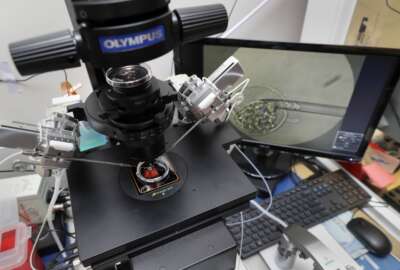Hubbard Radio Washington DC, LLC. All rights reserved. This website is not intended for users located within the European Economic Area.
‘Give it a rest,’ USPTO chief tells patent critics
USPTO director David Kappos says software is every bit as entitled to patent protection as hardware innovations. Critics of the agency should give recent refo...
wfedstaff | April 17, 2015 4:24 pm
The director of the U.S. Patent and Trademark Office offered a forceful defense of his agency and of the patentability of software amid an ongoing debate over whether software ought to be entitled to patent protection.
While USPTO chief David Kappos acknowledged software is a challenging topic, critics need to let the system work as various updates to the nations’ patent laws come into effect, he said Tuesday in a speech at the Center for American Progress.
“The key provisions of the America Invents Act have just gone into effect two months ago, and our initiatives within PTO are just newly effective as well,” he said. “So, to the commentators declaring the system is broken, I say: Give it a rest already, and give the AIA a chance to work. Give it a chance to even get started.”
Ongoing patent war

Kappos’ comments come in the context of an ongoing patent war between the largest makers of smartphones and mobile operating systems. The most visible battle reached a climax three months ago when a federal jury found Samsung had violated several patents held by Apple and ordered a $1 billion payment to the maker of iPhones and iPads.
While the two companies’ court battles over handheld gadgets involve the intellectual property of both hardware and software, some critics of the patent system have used the case to argue that software patents ought to be eliminated altogether.
Kappos made it clear he disagrees.
“Because many breathtaking software-implemented innovations power our modern world at levels of efficiency and performance unthinkable 50 years ago, patent protection is every bit as well-deserved for software-implemented innovation as for the innovations that enabled man to fly, and before that for the innovations that enabled man to light the dark with electricity, and before that for the innovations that enabled the industrial revolution,” he said. “To those commenting on the smartphone patent wars with categorical statements that blame the ‘broken’ system on bad software patents, I say get the facts. They don’t support your position.”
USPTO undertook own research
Kappos said the Patent and Trademark Office wanted the facts too, so it did its own research on whether its examiners are up to snuff in tackling the highly-technical and constantly changing area of software innovation as it decides whether or not a particular patent application should be granted. PTO decided to look specifically at patents it had granted that wound up being topics of litigation in the smartphone industry.
“We decided to undertake our own study to look at the U.S. patents involved in some of the highest profile litigation among major firms in the smartphone industry. We found that in the vast majority of these cases, over 80 percent, the courts have construed the software patents at issue as valid,” he said. “And an ongoing look at statistics in USPTO bear out a similar conclusion — rejections in software patent applications taken to our appeals board are upheld at a slightly higher rate than for the office as a whole, and those few decisions appealed to the Federal Circuit are affirmed 95 percent of the time.
While the patent system is designed to encourage innovation by giving inventors an incentive to release their ideas into the marketplace and describe how they work, critics say USPTO has done the opposite: discouraging innovation by issuing patents for software that are so broad that their holders can sue potential competitors over frivolous issues, then leaving it to the courts to sort out the mess.
Another criticism: Software patents are big business — so big that only big companies like Apple and Google can afford to participate. One recent analysis of corporate filings by the New York Times found the smartphone industry now spends more on patent fights than it does on research and development.
But Kappos said smartphones are certainly not the first subject of an expensive patent war and won’t be the last. He said since many breakthrough innovations such as GPS and robotic surgery interweave both inventive hardware and software, it would be imprudent and discriminatory to hold software innovation to a different standard.
“Why would we tell the team working on a clamp that holds a scalpel their innovation is worthy of protection, but tell the programmers whose algorithm guides that clamp with unerring precision their innovation is not?” Kappos said. “And what amount of venture capital would that team of innovators raise if half of their innovation was free to be lifted by their competitors the moment they put it in the marketplace? Discrimination against a form of innovation that is increasingly critical to technological advancement, indeed that in many areas dominates technological advancement, makes no sense.”
Kappos: Software patents to be more consistent
That doesn’t mean USPTO doesn’t face challenges with software patents, Kappos acknowledged. He says the agency believes patents for software need to be narrowly tailored.
“Programmers need to be able to write code and engineers need to be able to design devices without fear of unfounded accusations of infringement,” he said. “And we know that inconsistency in software patent issuance causes uncertainty in the marketplace and can cause threats of litigation that in turn can stifle innovation and deter new market entrants. At the USPTO, we recognize this as a serious concern.”
But Kappos said those concerns should be mitigated by the fact that that PTO’s decisions have been mostly upheld in the court system and by the America Invents Act, the patent reform overhaul President Obama signed a year ago. One provision lets outside parties issue challenges to patents if they think a patent examiner gave the go-ahead without knowing all the relevant facts.
“Given the enormous amount of prior art information now available and its innumerable sources, it can be challenging for a patent examiner to find all the relevant prior art for every patent application,” he said. “It’s worse still for software, where much prior art is in the form of previously written software, which is difficult to find and more difficult to understand unless you wrote it.”
Under the new patent law, third parties can submit prior art to PTO examiners to in reference to patent applications, Kappos said. As of last Tuesday — just two months after implementing the new law — the agency has received nearly 150 third-party submissions covering all types of technologies, including software, he said.
Kappos said PTO also has strengthened its guidelines for when a patent should be granted, invested in training for its patent examiners, and given them more time to research the details of complicated patent applications when it’s not easy to determine whether or not there’s prior art. More than 17,000 hours of technical training was provided to examiners last year, Kappos said, including 32 specific software-related courses.
RELATED STORIES:
Apple vs. Samsung legal battles summarized
Apple’s victory means soul-searching for Samsung
Congress sends patent overhaul bill to president
Copyright © 2024 Federal News Network. All rights reserved. This website is not intended for users located within the European Economic Area.
Jared Serbu
Jared Serbu is deputy editor of Federal News Network and reports on the Defense Department’s contracting, legislative, workforce and IT issues.
Follow @jserbuWFED
Related Topics





